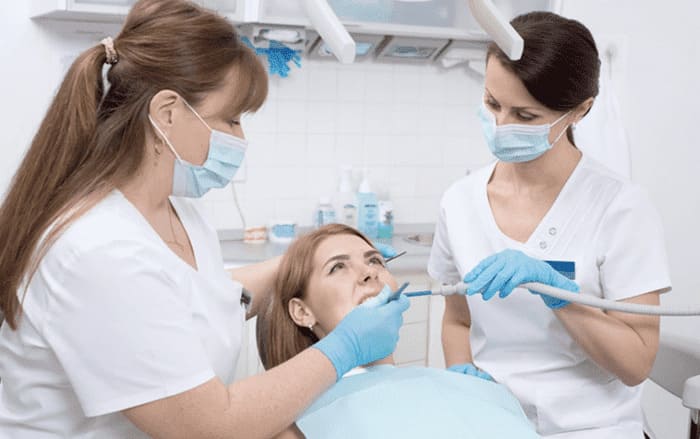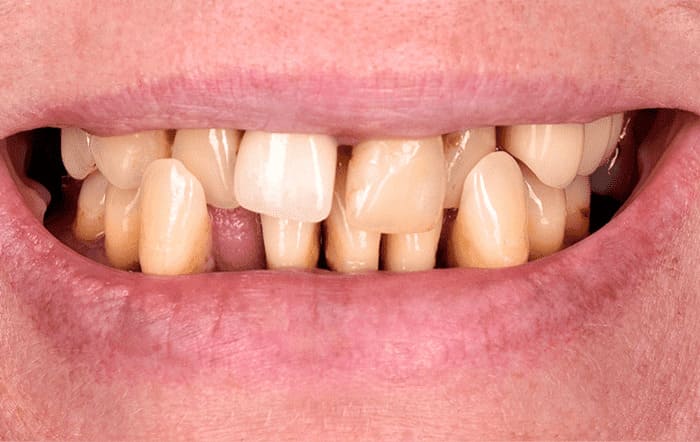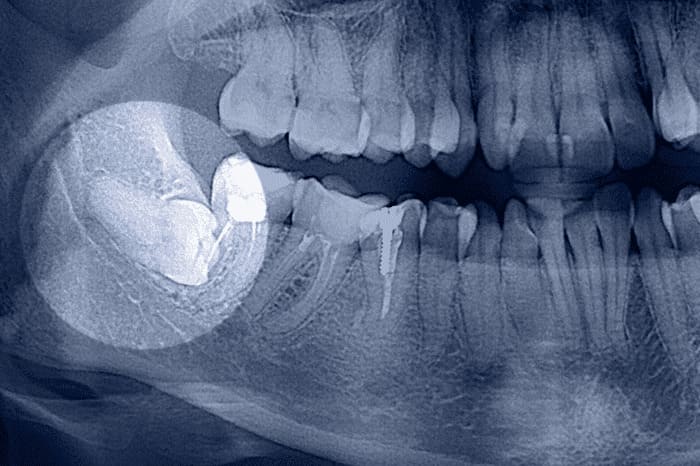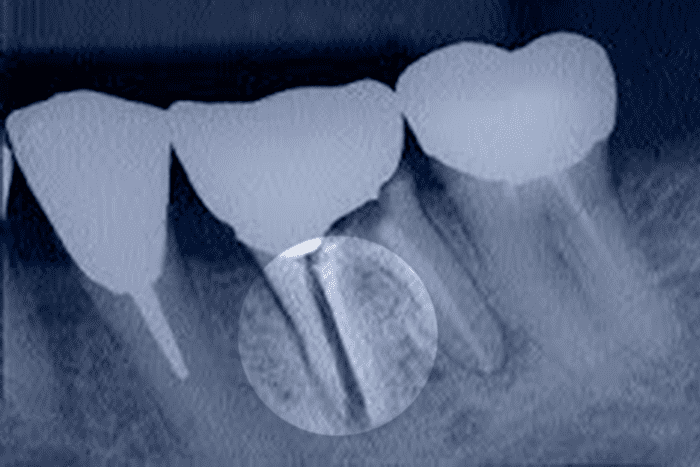Why Is the Gum Stitched After Tooth Extraction?

Contents:
Dentists perform tooth extraction for many reasons – in case of severe mobility, root fracture, incorrect position, hyperdontia, etc. Sometimes after a dental nerve removal, decay can develop under the crown; if detected too late, the tooth is difficult to save.

In some cases, after the extraction, the doctor sutures the gum. The socket is closed:
- after complex extraction of “wisdom teeth” (diverted, displaced, with irregularly bent roots);
- in one-stage implantation, when a titanium screw is immediately placed instead of the damaged tooth;
- to prevent bleeding in patients with gingivitis, periodontitis, blood clotting disorders after tooth extraction with extensive caries, etc.
Why suture the wound?
Joining the edges of the socket helps:
- preserve the blood clot;
- reduce the risk of complications (food particles or germs can get into the open wound);
- stop bleeding;
- reduce painful sensations after surgery;
- accelerate wound healing;
- preserve the shape of the gum.
What Materials Are Used In Oral Surgery?
Surgical sutures are of two types:
- Absorbable
Natural or artificial biodegradable materials (polypropylene, lavsan, kapron, catgut), capable of self-disintegration after some time. After suturing, securely hold the wound edges, then gradually dissolve.
- Non-absorbable
Cotton, silk, and linen – durable materials, which, after the scar formation, should be removed from the gum.

What to do After Stitching the Gum?
The sutures do not require special care. To accelerate the regeneration process, adhere to the following rules:
- do not eat within 3 hours after the suturing of the socket – food particles can get inside or undermine the suture material;
- eat only liquid and soft foods for the first week to avoid damaging the gingival mucosa;
- do not chew on the side where the surgery was performed;
- refuse spicy, hot, and very salty foods – such foods irritate the gingival mucosa and slow down healing;
- do not smoke; avoid drinking alcohol;
- monitor blood pressure, do not stimulate its increase – sauna, bath, airplane flights, diving, hard physical labor, and sports can raise blood pressure and cause bleeding;
- take medications prescribed by your dentist – painkillers and antimicrobials can help with postoperative discomfort and speed up the healing process.
Can I Remove Sutures from the Gum by Myself?
The time of suture removal is determined by the dentist, considering the condition of the post-surgery scar. The speed of wound healing depends on the following:
- the amount of intervention performed;
- the patient’s age, immune system, and hormones;
- presence/absence of complications.
Sutures are most often removed 5-10 days after suturing. Absorbable sutures are also removed so they do not stay in the gum for long and do not provoke inflammation.
The sutures are removed as follows:
- the gum surface is disinfected with an antiseptic solution;
- if the patient has a low pain threshold, a local anesthetic may be used before suture removal;
- the dentist cuts the threads with surgical scissors and removes them from the scarred wound using anatomical forceps;
- the gingiva is re-disinfected.

Sometimes, sutures bother the patient, and there is no way to get to the dentist. Should they pull them out on their own if there is no pain or swelling?
We strongly advise against it. Only a dentist should remove the stitches. Therefore, it is absolutely necessary to get to the doctor. KES Clinic is open from Fri to Sat. We will always help you to solve the problem quickly.
Post-Operative Instructions
For a quick periodontal recovery, you should follow a few guidelines:
- brush your teeth with a soft toothbrush;
- use rinses with anti-inflammatory properties; after each meal, you can rinse your mouth with warm water or decoction of herbs;
- temporarily exclude hard, salty, acidic, and spicy foods from your diet that can irritate the mucous membrane.

What Happens If You Do Not Remove the Stitches from the Gum?
The doctor decides to remove the threads when the wound looks healed visually. When the examination results indicate that the process is not complete, the suture removal has to be postponed for several more days.
When Are the Sutures Removed?
After surgical intervention, the wound heals completely within 2-3 weeks. Typically, the sockets of single-rooted teeth are tightened up to 14 days after surgery, and multi-rooted teeth – up to 20 days.
Tissue regeneration takes longer:
- in older people;
- vegetarians (due to protein deficiency in the diet);
- in diabetes mellitus, chronic skin lesions, and heart diseases.
What Happens If the Sutures Are Removed Early?
Early removal of the sutures can cause inflammation. A blood clot, which is necessary to form new tissue in the place of the extracted tooth, does not fully develop in the socket.
Delayed Sutures Removal
Delaying the removal of non-absorbable threads for more than a week can have unpleasant consequences:
- ingrowth of the suture material into the gum tissue, in which case it will have to be surgically excised;
- inflammation of the wound if bacteria get under the suture;
- the appearance of a permanent opening, etc.
To avoid complications, contact the KES Clinic. Experienced doctors will help you solve your dental problems. It is better to visit a dentist early in the disease. This way, you will keep your teeth healthy for a long time.

